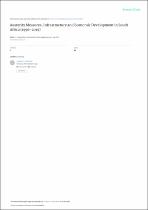| dc.contributor.author | Mali, Kukhanyile | |
| dc.contributor.author | Sheefeni, Johannes | |
| dc.date.accessioned | 2024-01-25T08:05:58Z | |
| dc.date.available | 2024-01-25T08:05:58Z | |
| dc.date.issued | 2023 | |
| dc.identifier.citation | Mali, K. and Sheefeni, J., 2023. Austerity Measures, Infrastructure and Economic Development in South Africa (1996–2019). Organizations and Markets in Emerging Economies, 14(1 (27)), pp.56-82. | en_US |
| dc.identifier.uri | https://doi.org/10.15388/omee.2023.14.82 | |
| dc.identifier.uri | http://hdl.handle.net/10566/9261 | |
| dc.description.abstract | The paper aims to establish whether austerity measures promote economic development, improve infrastructure development, and whether they exacerbate infrastructure backlogs. The methodology used is a quantitative research method, sourcing secondary quarterly data from the South African Reserve Bank. The VAR model is used to analyse data between 1994 and 2019. The results showed that austerity measures have a significantly negative role in economic development. Also, they slow down investments that are crucial for infrastructure development. The results also pointed to the exacerbation of infrastructure backlogs caused by austerity measures | en_US |
| dc.language.iso | en | en_US |
| dc.publisher | Vilnius University Press | en_US |
| dc.subject | Austerity | en_US |
| dc.subject | Infrastructure development | en_US |
| dc.subject | Economic development | en_US |
| dc.subject | Fiscal policy | en_US |
| dc.subject | Neoliberalism | en_US |
| dc.title | Austerity measures, infrastructure and economic development in South Africa (1996–2019) | en_US |
| dc.type | Article | en_US |

